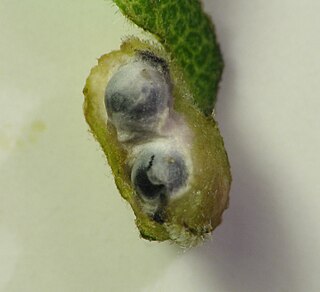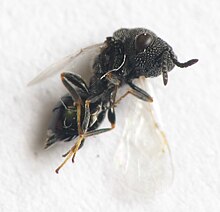
Chalcid wasps are insects within the superfamily Chalcidoidea, part of the order Hymenoptera. The superfamily contains some 22,500 known species, and an estimated total diversity of more than 500,000 species, meaning the vast majority have yet to be discovered and described. The name "chalcid" is often confused with the name "chalcidid", though the latter refers strictly to one constituent family, the Chalcididae, rather than the superfamily as a whole; accordingly, most recent publications (e.g.,) use the name "chalcidoid" when referring to members of the superfamily.

The family Agaonidae is a group of pollinating and nonpollinating fig wasps. They spend their larval stage inside the fruits of figs. The pollinating wasps are the mutualistic partners of the fig trees. The non-pollinating fig wasps are parasitoids. Extinct forms from the Eocene and Miocene are nearly identical to modern forms, suggesting that the niche has been stable over geologic time.

The Eucharitidae are a family of parasitic wasps. Eucharitid wasps are members of the superfamily Chalcidoidea and consist of three subfamilies: Oraseminae, Eucharitinae, and Gollumiellinae. Most of the 55 genera and 417 species of Eucharitidae are members of the subfamilies Oraseminae and Eucharitinae, and are found in tropical regions of the world.
Signiphoridae is a small family of parasitic wasps in the superfamily Chalcidoidea. The roughly 80 species are placed in four genera.

Galeopsomyia is a New World genus of hymenopteran insects of the family Eulophidae. The genus is a hyperparasitoid of other gall-inducing wasps of the genera Eurytoma and Torymus.

Tamarixia is a genus of hymenopteran insects of the family Eulophidae, they are parasitoids of Jumping plant lice or psyllids of the superfamily Psylloidea, although some species will parasitise aphids. Most species appear to be ectoparasitoids but at least one species has been recorded as an endoparasitoid.
Ablerus is the only genus in the family Azotidae. The genus was created by the American entomologist Leland Ossian Howard in 1894 for the species named in that year by William Harris Ashmead as Centrodora clisiocampae. The genus Azotus was synonymized with Ablerus by Alexandre Arsène Girault in 1913 and Hyatt synonymized Myocnemella with Ablerus in 1994, leaving Ablerus as the sole genus within the subfamily Azotinae. Azotinae was elevated in rank in 2013 to become the monotypic family Azotidae.

Megastigmus is a genus of minute wasps. There are more than 134 described species, more than half of which undergo larval development within the seeds of trees and shrubs.

Cleonymus is a genus of wasps in the family Cleonymidae.

Entedoninae is a subfamily of wasps in the family Eulophidae. The subfamily includes over 90 genera.

Eulophinae is a subfamily of wasps in the family Eulophidae which includes over 90 genera.

Leucospis is a genus of wasps belonging to the family Leucospidae. Most species are brightly coloured with yellow and black patterning and about 2 cm long. They have characteristically enlarged femurs on the hind leg, with the lower margin toothed. The wings have a longitudinal fold and the long ovipositor is bent over their backs above the abdomen or metasoma. They are parasitic on wasps and solitary bees that construct cells and provision food for their offspring. The Leucospis larvae live and grow as ectoparasites of the host larvae. Usually, only one parasite emerges from a single cell. The genus Micrapion from South Africa is very closely related, and phylogenetic studies suggest merging of the two genera. The genus Leucospis is found across the world in the tropical regions.

Conura is a genus of chalcidid wasps in the family Chalcididae, containing more than 300 species described. They are distributed mostly in the New World, especially in the Neotropical region, where 279 species occur. Conura is divided into three subgenera and 63 species groups, which may not form taxonomic entities but reflect patterns of morphology that are useful for focused studies.

Eucharitinae is a subfamily of chalcid wasps in the family Eucharitidae.

Dirhinus is a genus of parasitic wasps in the family Chalcididae. The genus has a worldwide distribution.
Plutarchia is a genus of chalcid wasp in the subfamily Eurytominae. Alexandre Arsène Girault first circumscribed the genus in 1925; its name honors Plutarch. The genus initially only comprised its type species, P. bicarinativentris, found in Australia. Subsequent species from South Asia and Nigeria have been described and transferred to Plutarchia.

Chalcedectidae is a small family of chalcid wasps, previously classified as part of the subfamily Cleonyminae, in the polyphyletic family Pteromalidae. Most species are parasitoids of wood-boring beetles.















